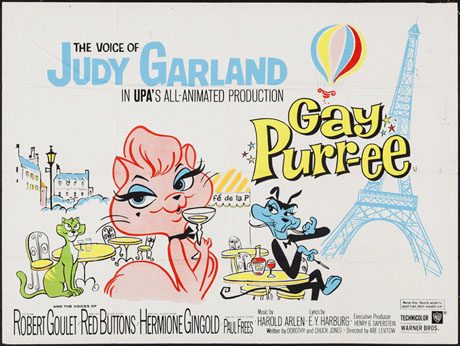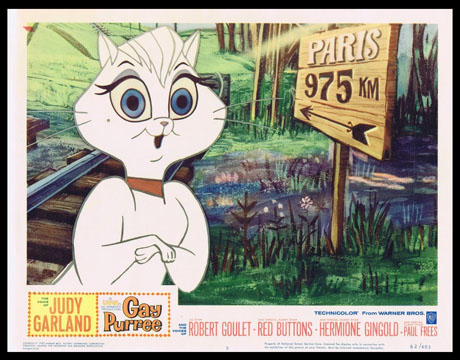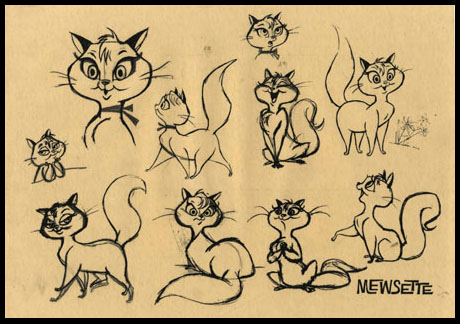
Gay Purr-ee is an example of two distinct animation styles coming together perfectly. The feature film was produced by United Productions of America (UPA) studios, revolutionizing animation with their distinctive graphic style. Also, Gay Purr-ee was written by animation legend Chuck Jones and his wife Dorothy Webster Jones.
The recognizable “UPA look” is on full display here, particularly in the flat, stylized background designs, which are coupled with what can best be termed the “1960s Chuck Jones-style,” seen in his work with the Tom & Jerry cartoons for MGM and his classic TV Christmas special How the Grinch Stole Christmas.

Although both different, UPA and Jones live comfortably together in Gay Pur-ee, celebrating its 60th anniversary this year.
As contributing writer Andrew Leal said of Gay Pur-ee in Jerry Beck’s book, The Animated Movie Guide: “While not as memorable as such UPA shorts as Rooty Toot Toot or The Tell-Tale Heart, the film is still a good effort and has been unjustly underrated through the years.”
Directed by Jones’ longtime Warner Bros. collaborator Abe Levitow, Gay Pur-ee tells the story of Mewsette, a lovely female cat living on a farm in the French countryside. A tom cat named Jaune Tom is in love with Mewsette, but she wants more and runs away to Paris.

On the way, she encounters Meowrice, the film’s villain, who promises to partner her with the Persian cat, Madame Rubens-Chatte, who will groom her as a debutante, but he wants to sell Mewsette as a mail-order bride to an American cat (named Henry Phtt).
Jaune Tom, and his buddy, the tiny cat, Robespierre, set off to Paris to find Mewsette. They tangle with Meowrice, who eventually winds up selling them to a ship bound for Alaska, where they end up. But – spoiler alert – fear not, Jaune Tom and Robespierre will return to Paris to defeat Meowrice and reunite with Mewsette.
Set in 1895 and mainly in Paris, Gay Pur-ee takes full advantage of the artistic possibilities of its backdrop. Art director Victor Haboush and the background artists explore all the animated possibilities of the countryside of Provence, as well as Parisian landmarks like the Arc de Triomphe and, of course, the Eiffel Tower.
Mewsette’s train ride to the city is particularly striking, as it combines the UPA style of the time and hints of great French artwork. Adding to that sequence is Mewsette performing one of the film’s songs, “Roses Red, Violets Blue,” an upbeat, infectious number that sparkles thanks to Judy Garland, who provides the voice of Mewsette.

Casting the iconic Garland was a big deal for Gay Pur-ee (evidenced by her name and image appearing before the film’s title in the opening credits). Her talent shines through in the movie, particularly during the musical numbers.
Another is a lovely ballad entitled “Take My Hand, Paree,” where Garland’s voice soars. The songs in Gay Pur-ee were created by Harold Arlen and Yip Harburg, both legends who had given us some of the greatest music in movie history with The Wizard of Oz. The production notes of the DVD state that Garland suggested Arlen and Harburg, who had crafted her iconic song “Somewhere Over the Rainbow,” for Gay Pur-ee (for more on the music from the film, read Greg Ehrbar’s Cartoon Research article from October of 2017.
Arlen and Harburg’s songs also allow director Levitow and his animators to create surreal moments, such as “Bubbles,” in which Jaune Tom and Robespierre get drunk on the bubbles from champagne. The musical sequence employs shapeshifting, giant bubbles, and Can-Can dancers.
“Bubbles” is also a perfect platform singer Robert Goulet and comedian Red Buttons, who provide the voices of Jaune Tom and Robespierre, respectively. With Garland, they both make up an impressive cast in the film, which includes Hermione Gingold, as Madame Rubens-Chatte, Morey Amsterdam, of The Dick Van Dyke Show, as the narrator, as well as Mel Blanc, Julie Bennett, Joan Gardner, and Thurl Ravenscroft and The Mellomen in other roles.

Stealing the show is Paul Frees, the amazing voice actor who was ubiquitous in animation in the 60s and 70s as Meowrice. Frees delivers an outstanding, silky performance and helps craft a memorable movie villain.
The character is one of the many distinctive elements of Gay Purr-ee. Another is a beautiful sequence in which Meowrice has Mewsette’s portrait done by “the most famous artists in Paris, many of them not well known yet in America.”
What follows is a montage of images of Mewsette inserted into famous paintings by renowned artists Claude Monet, Henri de Toulouse-Lautrec, George Seurat, Henri Rousseau, Amedeo Modigliani, Vincent Van Gogh, Edgar Degas, August Renior, Paul Cezanne and Pablo Picasso
Such an entertaining, humorous, and educational sequence like this and others in Gay Pur-ee could only be accomplished by an all-star team of artists, which director Levitow assembled for the film. Irv Spence, Hal Ambro, Ken Harris, Ben Washam, and Don Lusk are some of the many legendary names from animation who worked on the film.

The mixed critical (and audience) reaction had the film quickly relegated to double bills in its first run.
An unfortunate “blemish” associated with Gay Pur-ee happened when Warner Bros became involved with the film. Author Michael Barrier detailed this in his book, Hollywood Cartoons: American Animation in its Golden Age: “Warner Bros. learned of Jones’s involvement the next year when it became the film’s distributor, and there followed sharp disagreement over whether it had authorized Jones to moonlight in that way. On July 23rd, 1962 – after he had been on an unpaid leave of absence for several weeks – Jones signed an agreement ending his almost thirty years of employment by Warner Bros.”
Released on December 17, 1964, Gay Pur-ee received somewhat positive reviews from critics but unfortunately did not fare well at the box office.
While time and an animation landscape that has gotten more crowded since have allowed Gay Pur-ee to fade in memory through the years, the 60th-anniversary milestone is a nice reminder that this creatively unique film, crafted by so many who gave us the golden age of animation, deserves a revisit.
- An Eye for A Classic: The 60th Anniversary of “Mr. Magoo’s Christmas Carol” - December 22, 2022
- A Very Merry Mickey: The 70th Anniversary of “Pluto’s Christmas Tree” - December 19, 2022
- A Fine French Feline Film: The 60th Anniversary of “Gay Pur-ee” - December 12, 2022


 December 12th, 2022
December 12th, 2022  Michael Lyons
Michael Lyons  Posted in
Posted in  Tags:
Tags: 






